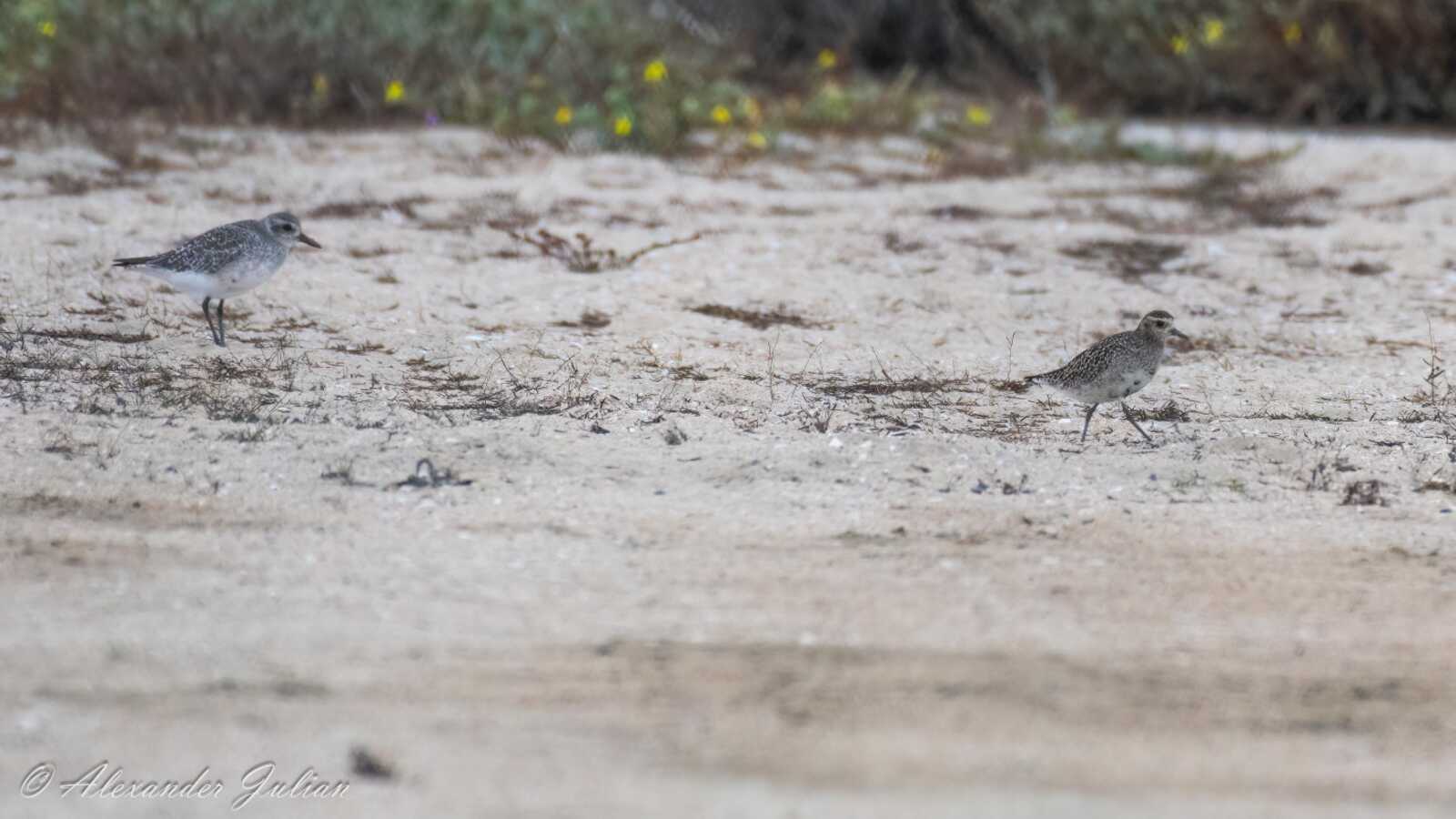
Quiz for May 2023
Quiz kindly prepared by Alex.
In this photo taken in Orange County in August, you can see two birds. Are these two birds the same or different?
Answer will be displayed on June 1.
Answer:
From the setting, we can deduce that these two birds appear to be on a sandy beach, and right away, we can see that they are probably shorebirds. In Southern California, we can see close to 20 different types of shorebirds, which can make identifying them challenging. Using shape, size, color, behavior, and unique traits can all help with ID.
In this photograph, these shorebirds have large eyes relative to the size of the head, short stubby bills, and long legs, and the bird on the left is standing still, which are typical behavior and traits of plovers.
We can see a few plovers in Southern California, including Pacific Golden-Plover, American Golden-Plover, Black-bellied Plover, and Mountain Plover, all of which look rather similar to our quiz birds.
American Golden-Plover: found on farm and sod fields, mudflats, and shorelines. This is a rare visitor to So. Cal and is usually seen only during fall migration, in mostly winter plumage. They are a smaller plover with a large eye, gray underwings (lacking the black armpits of Black-bellied Plovers), long legs, a thin, short bill, and a drab brownish color with light mottling, with a golden wash, and no white on the rump. A pale eyebrow is strong in juveniles. A key ID trait on this plover is that four evenly spaced primaries extend well past the tail, which other plovers do not have.
Black-bellied Plover: found on beaches, wetlands, and sod farms. They have a heavy body, thick neck, white rump, stubby bill, smudgy face and breast, dark grayish plumage with streaked underparts, and a short primary projection. In all ages, they have distinct black armpits and are the largest of the plovers. They are also the only plover to have a hind toe, although it is often difficult to see. These plovers winter in So. Cal regularly.
Pacific Golden-Plover: found on beaches, mudflats, fields, and grassy areas (i.e., golf courses). This is a medium-sized Plover with a short, thick bill, pale eyebrow, large eye, smudgy breast, faint gold speckles on the back, and a dark rump. They look very similar to the American Golden-Plover, and are best separated by a shorter primary projection, generally having three or fewer exposed primaries extending only slightly beyond the tip of the tail. These Plovers are uncommon visitors to So Cal mainly in late summer/fall and winter.
Mountain Plover: found in prairies, agricultural fields, bare dirt fields, short grass areas, and along the coast. They are a medium-sized, drab plover with a pale face, a buffy breast, a thin dark bill, and white underwings. They winter in So Cal.
As we can see in the picture, these are two different types of Plovers, as the size difference is obvious. The bird on the left looks quite large and stocky. It has a thick neck, a smudgy face, a grayish tone overall, and a short primary projection. In addition, we can actually see the presence of a hind toe on its left leg! This leads us to ID it as a Black-bellied Plover.
The Plover on the right is smaller, with a thin, short bill, short primary projections, and pale eyebrows. It has a mottled back with a light golden wash to it. Since the primary projection is short (barely extending past the tip of the tail), this rules out an American Golden-Plover, and both birds are not Mountain Plovers due to the extensive mottling on the back, as Mountain Plovers are quite drab with very little mottling. Also, Mountain Plovers prefer fields and prairies. All this evidence leads us to conclude that this is a Pacific Golden-Plover. This identification is supported due to the obvious pale eyebrow, smudgy breast, thin bill, dark spot just behind the eye, and faint gold speckling on the back.
Congratulations to Thomas L. and Lily for correctly answering Black-bellied Plover and Pacific Golden-plover!